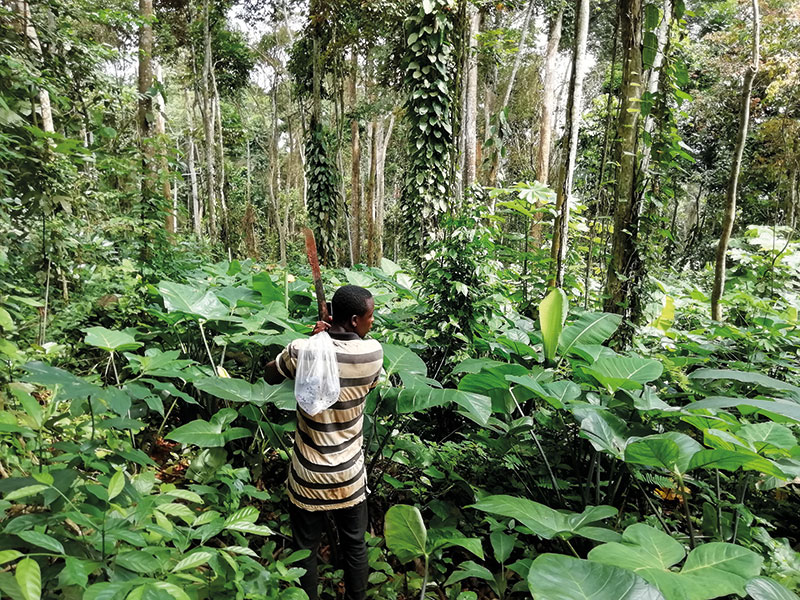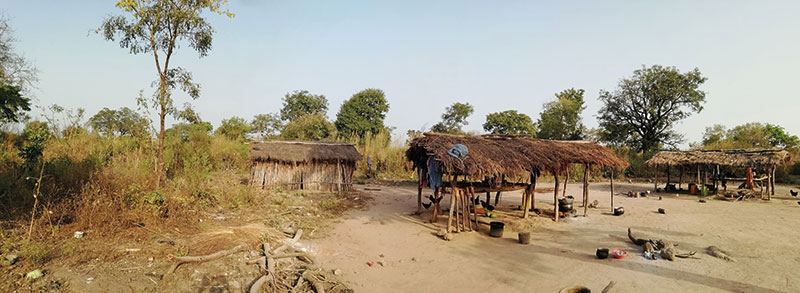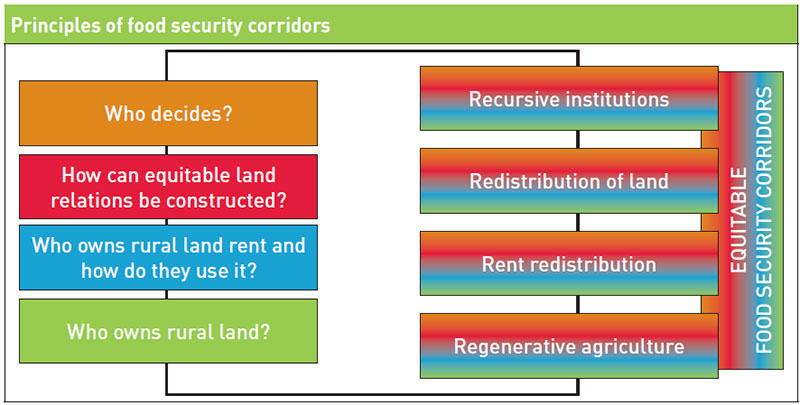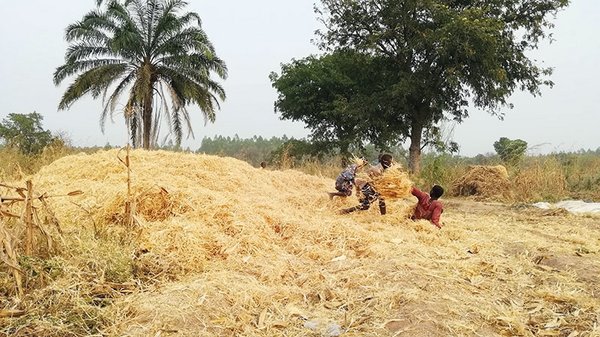 Download this article in magazine layout
Download this article in magazine layout
- Share this article
- Subscribe to our newsletter
Food security corridors – a promising solution to conservation and resource-grabbing conflicts
Tropical forest ecosystems are rich in biodiversity and carbon, providing essential ecosystem services and supporting the livelihoods and cultural heritage of hundreds of millions of people world-wide. Yet these ecosystems are imperilled by multiple pressures such as deforestation and fragmentation, which are fuelled by human activities, including logging and agriculture. In some instances, conflicts emerge between forest conservation interventions and the rights and needs of vulnerable communities reliant on forests for their subsistence, income and well-being. One example of this conflict is the encroachment and farming in protected areas, or land grabs, which results in social conflicts, insecurity, land-use change and ecosystem degradation.
Resources enclosures, conflicts and food insecurity
Many forest-fringe communities across sub-Saharan Africa are increasingly struggling to acquire arable lands for food production due to multiple pressures. These pressures include the conversion of communal lands to protected forests and large-scale land acquisition by rich countries, multinationals and local elites. At the same time, climate change impacts are also shrinking the areas available to such communities for food production. Traditional authorities own most land in Africa, but some local communities face obstacles in using such lands to overcome food insecurity and build resilience to climate impacts.
Protected forests serve multiple purposes such as eco-tourism, biodiversity protection and climate moderation, but they also create conflicts where they prioritise environmental protection over the rights and well-being of local communities. Large-scale land acquisition, which accelerated during the 2008 financial crisis, is creating conflicts in host communities in many African countries, where multinationals have largely failed to use accumulated lands to create green jobs, e.g. through biofuel, tree plantations, carbon offsets and related interventions. Finally, the growing conversion of food crop farms into export-commodity plantations, including oil palm, cotton, cashew, coffee and cocoa, drives land accumulation from below, impeding marginalised local communities’ ability to secure the production of food for their subsistence.
These trends create tensions and become a time bomb, especially when local communities are unable to make a living from the initiatives that take away their land unfairly. The loss of land, together with structural barriers such as low investment in crop productivity enhancement, extension services and value chain development, and high unemployment, push forest-fringe communities in many SSA countries to encroach into forest reserves to produce food crops, often as a last resort to survive. Crop expansion in protected areas in Africa increased from 74 km2 per year between 2003 and 2007 to 4,265 km2 per year (2015 and 2019), a 58-fold increase.
A global comparative study by scientists from Norway, Germany, Brazil and Indonesia in 2014 examined the relationship between forest clearance and rural livelihoods, using data from 7,172 households across 24 countries in Africa and Asia. They found that 27 per cent of the households had converted about 1.21 ha of forests to farms in the previous 12 months, with each household clearing 1.21 ha. In its 2016 State of the World’s Forest Report, the Food and Agriculture Organization of the United Nations (FAO) argues that small-scale farming accounts for 65 per cent of forest conversions in SSA. If the current trend continues, 2.1 per cent (314,214 km2) of protected forests will be converted to croplands by 2030, concluded a recent study published by Meng and colleagues in Nature Sustainability. This imperils the achievement of global biodiversity conservation goals to secure at least 30 per cent of land by 2030.
Crop expansion into protected areas undermines biodiversity and climate goals, but food insecurity remains a nagging challenge in many African countries. The World Bank estimates that 59.5 per cent (2019) of people in sub-Saharan Africa experience moderate or severe food insecurity. This is more than twice the global average of 27.6 per cent. Incidentally, the growing expansion of farms into protected areas does not resolve food insecurity in the region. Conflicts between public authorities and forest communities lead to the demolishing of crops on so-called illegal farms in protected areas. It also accelerates low-input, low-output shifting cultivation practices because without secured tenure, “illegal farmers” have no incentive to invest sustainably.
The biggest reinforcer of forest conversion is the neglect of forest communities’ voices and needs in forest politics and policies, which usually results in solutions that do not fit local contexts. There is an urgent need to transform the way in which policy actors involve local communities whose existence and well-being are threatened by resource grabbing across SSA. Here, food security corridors could help. They offer a novel way to design and implement land use interventions that responds to the voices and needs of local communities who need it the most. The approach emerged from our analyses of forest conversion and land-use conflicts in rural Ghana (also see Box below).
Two cases of resource-grabbing conflicts in Ghana
The Krokosua Hills Forest Reserve (KHFR) is one of 266 forest reserves in Ghana. Covering 48,100 hectares, the KHFR was enclosed in November 1935, with British colonial officials neglecting the concerns of Sefwi traditional leaders about farming and the well-being of their subjects. Today, struggles over farmlands in the area are rapidly depleting the KHFR, with 3.5 per cent lost from 2010 to 2019. A military-style task force assigned by the state only exacerbates the challenge, with KHFR-fringe communities using complex mechanisms to encroach, including farming with torchlights at night, deploying whistle-blowers and bribing forestry officials. The KHFR case is only a microcosm of the challenge, with similar cases leading to the emergence of reserves-on-paper, where a greater area of some forest reserves is, informally, farmland.
A farmer in an encroachment area within the Krokosua Hills Forest Reserve in Ghana’s Western North Region. Photos: Eric Mensah Kumeh
The company African Plantations for Sustainable Development (APSD) was founded by Aracruz Cellulose (AC) in 2010, following massive derivative losses and a bailout in Brazil from the 2008 financial crisis. Replicating AC's violent history of dispossessing indigenous communities in that country, the APSD has dispossessed several rural communities in Ghana’s Bono East Region, failing to live up to its promise of job creation, biofuel generation and rural development. Despite a downturn in its operations, the company uses military officials to deny host communities access to farmlands, fuelwood and other resources, leading to multiple conflicts, displacement and food insecurity in communities dispossessed by the APSD.
A make-shift housing by a group of farmers squatting within a land grab enclosure by the company African Plantations for Sustainable Development in Atebubu/Wiase.
Food security corridors for rural land-use transformation
By definition, a food security corridor (FSC) is a geographical area created around land enclosures, e.g. protected forests or large-scale land acquisition, to implement food security projects for people who traditionally depend on forests or land for most of their subsistence but are now trapped in inequitable land relations. FSCs enable actors to institutionalise food security by broadening food availability and access to marginalised communities over time. FSCs are not prescriptive. Instead, they combine multiple place-based interventions such as i) physical food security corridors that use redistributed land for climate-resilient and regenerative farming, ii) viable local non-farm livelihood sources and rural enterprises, and iii) income transfer schemes that compensate food-poor, vulnerable communities for losing their access to land.
Despite their flexibility, FSCs have a better chance of success when built on the principle of equity, tending to avoid critical questions concerning who owns the land, contributes to land-use decision-making and benefits from resource rents (see Figure). Implementing FSCs in areas characterised by inequitable land-use relations requires skilful negotiation, resilience and an orientation towards fairness or equity. This is because any form of land or associated rent (re)distribution may be perceived as a threat to those already benefiting disproportionately from prevailing inequitable land relations. FSCs’ partiality towards evidence-based multi-stakeholder deliberations offers an avenue to navigate entrenched interests and positions.
Overall, FSCs seek to nurture resilient and recursive institutions that overcome the challenges associated with one-off consent mechanisms that are typically used to create protected areas and sanction large-scale land acquisitions. For example, instead of tools such as one-off environmental and social impact assessments (ESIAs) that enable states and companies to legitimise forest or resource enclosures in perpetuity, FSCs favour novel tools or instruments that set critical benchmarks or milestones, the unfulfillment of which opens up the possibility for marginalised communities to renegotiate the terms of their dispossession. Such recursive tools may include food security provident funds, community well-being guarantees and local employment quotas.
Potential challenges and solutions
While promising, actors implementing FSCs must overcome a few challenges and risks, such as policy and governance challenges, the trade-off between goals, finance and market barriers, and sociocultural factors. The current plights, including food insecurity, in many forest-fringe communities are partly a product of governance problems and the complex challenge of finding a balance between nature conservation and social well-being. FSCs are not oblivious to these challenges. Alternatively, they embrace them, believing that inclusive processes which genuinely recognise power asymmetries among diverse actors open avenues for mutual respect, innovation and collective action. Multi-stakeholder deliberations needed to initiate an FSC may require significant investments in local research and capacity building. However, the high initial costs may be offset by the positive environmental and social impacts of halting further forest conversion, securing biodiversity and establishing carbon sinks while engendering sustainable livelihoods and well-being. Thus, investing in FSCs as a holistic and participatory approach is worthwhile.

The way beyond
While food security corridors remain a theoretical design at this stage, they offer a promising solution to the complex and challenging issues of forest conservation and land acquisition conflicts in sub-Saharan Africa. By promoting a more integrated and holistic approach to land use and natural resource management, they can help to reconcile the competing demands and interests of different stakeholders and to enhance the resilience and sustainability of food systems and ecosystems. However, the successful implementation and scaling up of FSCs require concerted efforts and investments from different actors and a robust commitment to adaptive management and monitoring and evaluation.
FSCs can be supported by investors, development practitioners, researchers and policy-makers who are concerned with sustainable and inclusive development. Policy-makers can create an enabling environment for mobilising private sector engagement and innovation towards delivering FSCs. Investors can provide financial and technical support, while development practitioners can integrate the principles of FSCs into their projects, working closely with local communities and governments. And researchers can map areas most suited for FSCs and develop robust frameworks for monitoring the economic and socio-ecological contributions and impacts of FSCs. Overall, FSCs offer a promising pathway towards sustainable development and can help achieve multiple Sustainable Development Goals by building resilient and equitable food systems, protecting and restoring tropical forests. The time for action is now!
Eric Mensah Kumeh is a postdoctoral researcher at the School of Geography and the Environment, and the Leverhulme Centre for Nature Recovery, University of Oxford, UK. He holds a doctorate from the University of Hohenheim, Stuttgart, Germany.
Contact: eric.kumeh(at)ouce.ox.ac.uk





Add a comment
Be the First to Comment